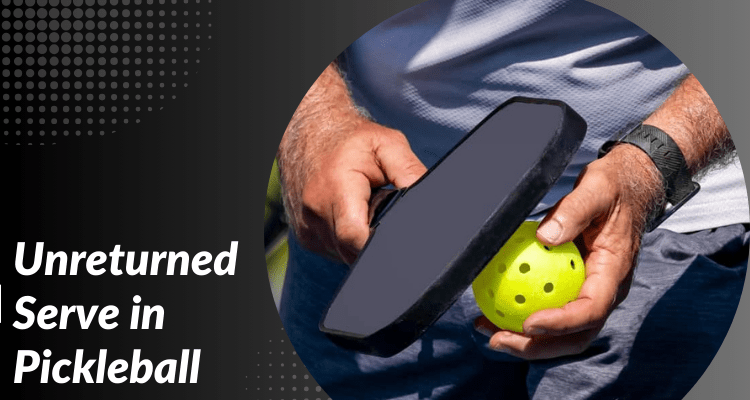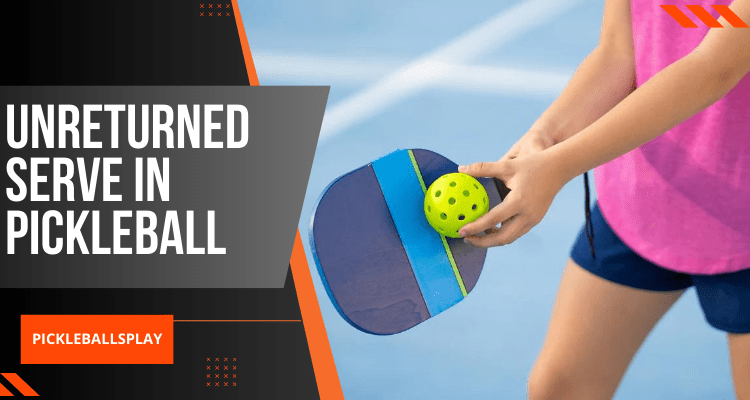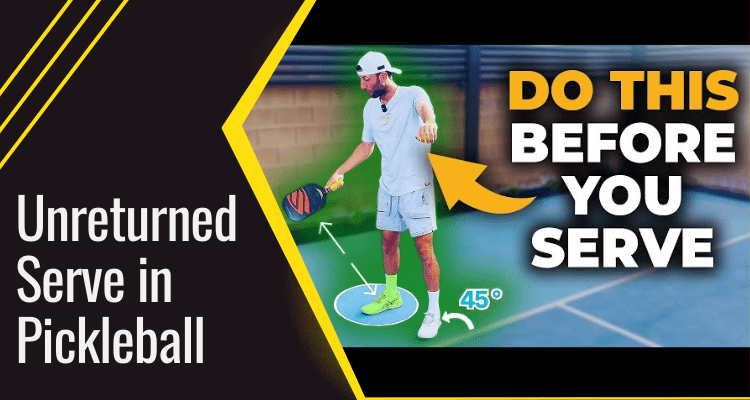The game has many rules. One important rule is about the serve. In this article, we’ll talk about unreturned serves in pickleball. We’ll explain what they are and why they matter. If you’re new to pickleball or want to improve your game, this info will help you. Let’s dive in and learn about unreturned serves in pickleball.
What is Unreturned Serve in Pickleball
An unreturned serve in pickleball is pretty simple. It’s when the receiving team can’t hit the serve back over the net. This can happen for different reasons. Maybe the serve was too fast or tricky. Or the receiving player might have made a mistake. When a serve isn’t returned, the serving team gets a point. This makes unreturned serves very important in pickleball.

Unreturned serves can change the game. They help the serving team score points quickly. Good servers try to make their serves hard to return. They use different techniques to confuse the other team. But remember, serves in pickleball must follow certain rules. We’ll talk about these rules next.
Unreturned Serving Rules in Pickleball
Pickleball has specific rules for serves. These rules affect how players serve and when a serve counts as unreturned. Let’s look at the rules for single players and two players.
For Single Players
In singles pickleball, serving rules are a bit different:
- The server must stand behind the baseline.
- They must hit the ball diagonally across the court.
- The serve must go over the net and land in the opposite service court.
- If the serve touches the net but still lands in the right area, it’s a “let.” The server gets to try again.
- If the receiver can’t return the serve, it’s an unreturned serve.
- The server gets a point for an unreturned serve.
Single players need to be good at serving and receiving. They cover the whole court by themselves. This makes unreturned serves even more important in singles games.
For Two Players
In doubles pickleball, the rules change a bit:
- Only one player on a team serves at a time.
- The serving team starts on the right side of their court.
- They serve diagonally to the opposite court.
- If they win the point, the same server moves to the left side and serves again.
- If they lose the point, the serve goes to their partner.
- When both partners lose their serves, the serve goes to the other team.
- An unreturned serve still counts as a point for the serving team.
In doubles, teams can use strategies for serving and receiving. They might try to aim serves at the weaker player. Or they might stand in certain positions to make returns easier.
Unreturned Serve Sequence Rules in Pickleball
The sequence of serves in pickleball is important. It affects when and how unreturned serves happen. Here’s how it works:

- At the start of the game, only one player or team gets to serve.
- This first server keeps serving until they lose a rally.
- When they lose a rally, the serve goes to the other team.
- In doubles, both players on a team get to serve before the serve switches sides.
- The sequence of serves must follow the score and player positions.
Understanding this sequence helps players know when to expect serves. It also helps them plan their strategy for returning serves. The goal is to avoid unreturned serves and win points.
What is an illegal serve in pickleball?
An illegal serve in pickleball won’t count as an unreturned serve. Here are some things that make a serve illegal:
- Hitting the ball above the waist.
- Using an overhand swing.
- Bouncing the ball before hitting it.
- Stepping on or over the baseline while serving.
- Hitting the ball into the wrong service court.
- Missing the ball when trying to hit it.
If a server does any of these things, it’s a fault. The serve doesn’t count. In doubles, the serve might go to the other player on the team. In singles, the serve goes to the other player. Illegal serves can’t be unreturned serves because they don’t count at all.
What is the rule for the return serve in pickleball?
The rules for returning a serve are just as important as serving rules. Here’s what you need to know:
- The receiving team must let the serve bounce once before hitting it.
- They can’t hit the ball in the air on a serve return.
- The return can go anywhere in the opposite court.
- The serving team must also let the return bounce once.
- After these two bounces, either team can volley the ball.
These rules make the start of each rally slower. This gives both teams a chance to get ready. If the receiving team breaks these rules, the serving team gets a point. This is different from an unreturned serve, though. An unreturned serve is when the receiving team follows the rules but still can’t get the ball back over the net.
What is a bad serve in pickleball?
A bad serve in pickleball is different from an illegal serve. A bad serve follows all the rules, but it’s not effective. Here are some examples:

- A serve that’s too high and slow, making it easy to return.
- A serve that lands close to the kitchen line, giving the receiver an advantage.
- A serve with no spin or strategy, making it predictable.
- A serve that always goes to the same spot, letting the receiver anticipate it.
Bad serves often lead to strong returns. This puts the serving team at a disadvantage. Good players try to avoid bad serves. They practice different serving techniques. The goal is to make serves that are hard to return. This increases the chance of getting unreturned serves and winning points.
Unreturned Serve in Pickleball FAQ
Here are some common questions about unreturned serves in pickleball:
Does an unreturned serve always result in a point?
Yes, an unreturned serve always gives a point to the serving team. This is why serving well is so important in pickleball. It’s a chance to score points directly.
Can you hit an unreturned serve in the kitchen?
No, serves must land in the service court, which is behind the kitchen line. If a serve lands in the kitchen, it’s a fault, not an unreturned serve.
What happens if a serve hits the net and lands in?
If a serve hits the net but still lands in the correct service court, it’s called a “let.” The server gets to serve again. This serve doesn’t count as unreturned.
Are there limits on how many unreturned serves you can hit?
There’s no limit on unreturned serves in pickleball. A player can score many points in a row with unreturned serves if they’re skilled enough.
Can you use spin on a serve to get more unreturned serves?
Yes, using spin on serves is legal and can make them harder to return. Many players use spin to increase their chances of getting unreturned serves.
Conclusion
Unreturned serves are a key part of pickleball. They offer a direct way to score points. Understanding the rules and strategies around serves can improve your game. Remember, a good serve follows all the rules and is hard to return. Practice different serving techniques to increase your unreturned serves.
At the same time, work on your serve return skills. This will help you avoid giving up points on unreturned serves. Pickleball is a game of strategy and skill. Mastering the serve and return can give you a big advantage. Keep practicing, and enjoy the game!



